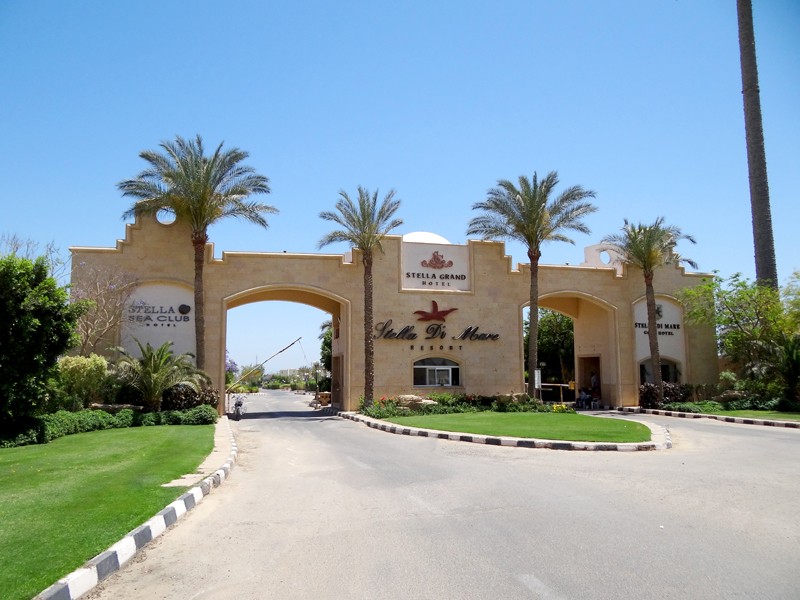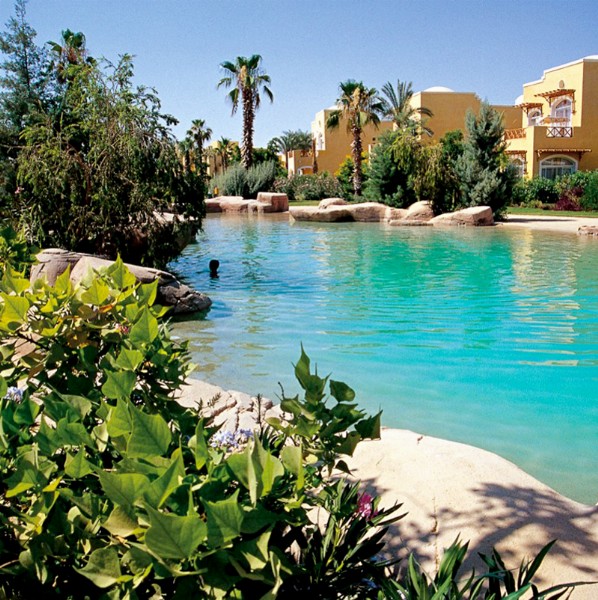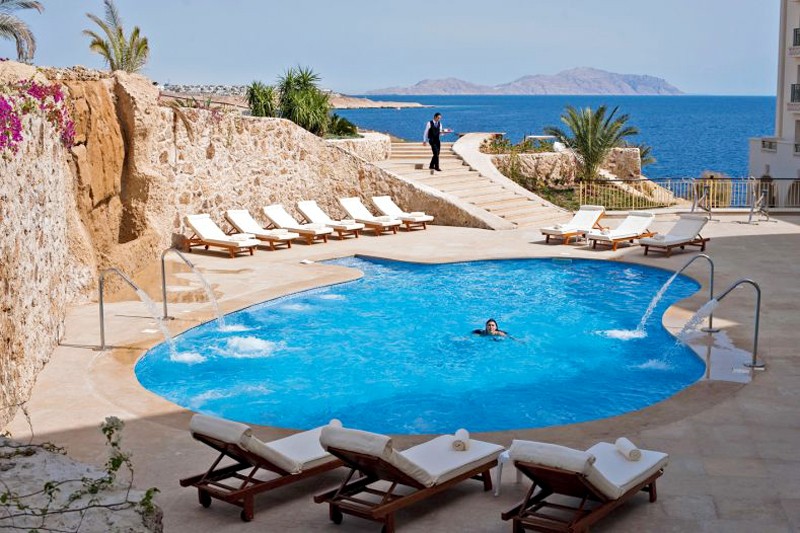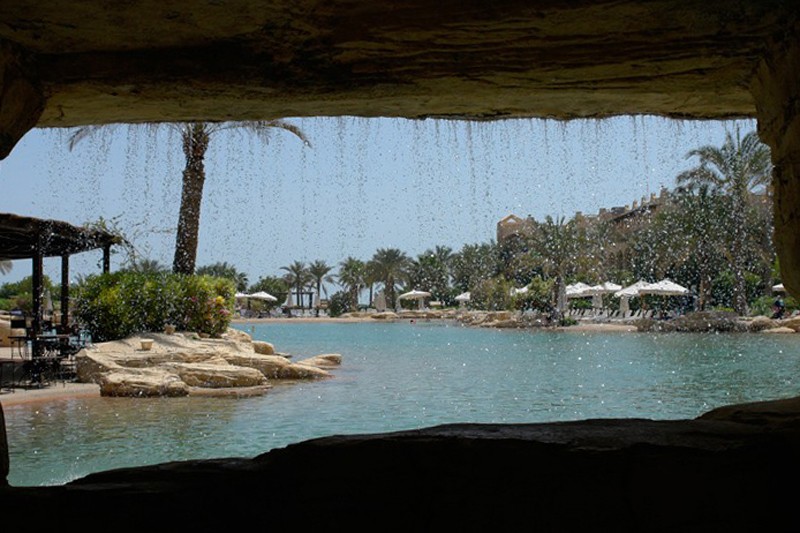Egypt: a stretch of desert overlooking the Red Sea and 49 hectares of sand to transform into an oasis
In just over a year parched sand was replaced by a lush garden of palm trees and tropical plants dotted with hotels and infrastructure, watered by a series of fountains, artificial lakes and swimming pools. The desert had flowered, a concept echoed in the very shape of the luxurious compound.
With the contrast between the reds and ochre of the desert and the emerald green of the new oasis’ gardens and golf courses offering a huge visual impact.
A broad avenue of palms leads visitors straight from the main entrance to the heart of the resort, where 5300 square metres of saltwater lagoon meanders between gentle waterfalls and pale ochre rocks.
Scattered around private villas nestle in the green, complete with every comfort and swimming pools, forming nine areas shaped like the petals of an exotic flower. Even more upmarket villas overlook the two golf courses. The whole complex also has plenty of specially-designed playgrounds to keep children happy. The entertainment area, shops, restaurants and other facilities form the centrepiece of the lagoon, which means they are handy for everyone, but with enough intervening space to ensure that the peace and privacy of the residential areas are respected.
Local materials have been used and the architecture harks back to traditional eastern styles, rich with the sandy colours of the desert and the blues of the sea, which have been used in the spa area. The spa is laid out like a traditional Hammam, with soft lighting, gentle steam and classically-tiled walls in sophisticated geometric patterns.
In an arid climate like that of the Egyptian desert, where irrigation and rainfall are both out of the question, the water supply ecosystem is the main issue in keeping the area green. So what was the answer? “Easy” replied architect Paghera “just look, learn and dialogue with the nature all around. The important thing is to study the native ecosystems closely and unravel their intricate mechanisms in the light of one’s knowledge of the traditions of the past, and then interpret them with the added help of the new tools and technology available today. Even the tiniest fragment of vegetation can help to create a garden, all you have to do is notice it”.
One thing Paghera certainly has plenty of is experience. Together with a very solid background in gardening. Paghera has masterminded a large number of environmental projects ranging from reforestation to anti-desertification strategies, always driven by a healthy respect for nature and a willingness to listen to its wisdom. And in Egypt Paghera recreated that marvel of biological engineering that is the oasis. An ecosystem with a temperature five degrees below that of the surrounding desert; oases provide shade, and plants thrive in shade from the fierce desert sun. Humidity, shade and vegetation are the three essential components which serve to create an ecological niche able to then attract other organisms to further enrich the biological environment, fostering a self-regenerating microcosm.
The existence and maintenance of an oasis relies on skilful techniques, traditions handed down orally from one generation to the next, the fruit of a harmonious use of resources, almost a masterpiece in environmental architecture. A perfectly organised ecological system run by man, where every single intervention has to be carefully calibrated because it has an effect on the whole.
At the Stella di Mare resort the oasis model has been reproduced on an enlarged scale. The ground has to contain exactly the right mix of sand and clay to ensure the water does not drain away, but keeps the soil moist. The plants, shrubs and trees are distributed in a precise pattern and quantity per square metre, any more or any less would upset the delicate balance of the whole system.
The land also needs nitrogen, an essential element for plant growth, and the desert is naturally poor in nitrogen. So the right number of nitrogen-fixing plants have to be included in the plans, pulses are particularly appropriate, because they absorb nitrogen from the air and fix it in the soil, functioning as natural fertilisers. Then of course no oasis would be complete without its palms, or phoenix dactylifera, the epitome of the desert plant, towering up to 10 metres and more. Here there are thousands, they have been planted all over the compound. These are all local plants, saved from being chopped up for firewood because they were no longer productive for the farmers who owned them.
In the past men used to shin up the tall date palms to pick their fruits, but nowadays farmers prefer younger trees which are not so tall, making it easier to harvest the dates. So mature palm trees are carefully uprooted and taken to special collection centres where they can be exchanged for younger trees: two young trees for each mature palm. The Stella di Mare palms all come from these collection centres and were swopped for two younger trees, then loaded onto camels and replanted in the complex.
“The delicate sound of running water in the fountains and over the rocks is the keynote”
The final result was a real eye-opener. A carpet of brilliant green woven with brightly-coloured, sweet-smelling flowers to the delicate sound of water gurgling in the fountains and over the rocks which look like sculpted sand, all providing a harmonious keynote for this huge resort, all carefully crafted to respect the environment and the cultural context it is set in.
Like a set of Chinese boxes the landscaped gardens radiate out from the centre in ever greater detail, blending perfectly with the smaller gardens surrounding the private villas. A little further on is the blinding blue of the Red Sea with its magnificent underwater seascapes.
In just over a year parched sand was replaced by a lush garden of palm trees and tropical plants dotted with hotels and infrastructure, watered by a series of fountains, artificial lakes and swimming pools. The desert had flowered, a concept echoed in the very shape of the luxurious compound.
With the contrast between the reds and ochre of the desert and the emerald green of the new oasis’ gardens and golf courses offering a huge visual impact.
A broad avenue of palms leads visitors straight from the main entrance to the heart of the resort, where 5300 square metres of saltwater lagoon meanders between gentle waterfalls and pale ochre rocks.
Scattered around private villas nestle in the green, complete with every comfort and swimming pools, forming nine areas shaped like the petals of an exotic flower. Even more upmarket villas overlook the two golf courses. The whole complex also has plenty of specially-designed playgrounds to keep children happy. The entertainment area, shops, restaurants and other facilities form the centrepiece of the lagoon, which means they are handy for everyone, but with enough intervening space to ensure that the peace and privacy of the residential areas are respected.
Local materials have been used and the architecture harks back to traditional eastern styles, rich with the sandy colours of the desert and the blues of the sea, which have been used in the spa area. The spa is laid out like a traditional Hammam, with soft lighting, gentle steam and classically-tiled walls in sophisticated geometric patterns.
In an arid climate like that of the Egyptian desert, where irrigation and rainfall are both out of the question, the water supply ecosystem is the main issue in keeping the area green. So what was the answer? “Easy” replied architect Paghera “just look, learn and dialogue with the nature all around. The important thing is to study the native ecosystems closely and unravel their intricate mechanisms in the light of one’s knowledge of the traditions of the past, and then interpret them with the added help of the new tools and technology available today. Even the tiniest fragment of vegetation can help to create a garden, all you have to do is notice it”.
One thing Paghera certainly has plenty of is experience. Together with a very solid background in gardening. Paghera has masterminded a large number of environmental projects ranging from reforestation to anti-desertification strategies, always driven by a healthy respect for nature and a willingness to listen to its wisdom. And in Egypt Paghera recreated that marvel of biological engineering that is the oasis. An ecosystem with a temperature five degrees below that of the surrounding desert; oases provide shade, and plants thrive in shade from the fierce desert sun. Humidity, shade and vegetation are the three essential components which serve to create an ecological niche able to then attract other organisms to further enrich the biological environment, fostering a self-regenerating microcosm.
The existence and maintenance of an oasis relies on skilful techniques, traditions handed down orally from one generation to the next, the fruit of a harmonious use of resources, almost a masterpiece in environmental architecture. A perfectly organised ecological system run by man, where every single intervention has to be carefully calibrated because it has an effect on the whole.
At the Stella di Mare resort the oasis model has been reproduced on an enlarged scale. The ground has to contain exactly the right mix of sand and clay to ensure the water does not drain away, but keeps the soil moist. The plants, shrubs and trees are distributed in a precise pattern and quantity per square metre, any more or any less would upset the delicate balance of the whole system.
The land also needs nitrogen, an essential element for plant growth, and the desert is naturally poor in nitrogen. So the right number of nitrogen-fixing plants have to be included in the plans, pulses are particularly appropriate, because they absorb nitrogen from the air and fix it in the soil, functioning as natural fertilisers. Then of course no oasis would be complete without its palms, or phoenix dactylifera, the epitome of the desert plant, towering up to 10 metres and more. Here there are thousands, they have been planted all over the compound. These are all local plants, saved from being chopped up for firewood because they were no longer productive for the farmers who owned them.
In the past men used to shin up the tall date palms to pick their fruits, but nowadays farmers prefer younger trees which are not so tall, making it easier to harvest the dates. So mature palm trees are carefully uprooted and taken to special collection centres where they can be exchanged for younger trees: two young trees for each mature palm. The Stella di Mare palms all come from these collection centres and were swopped for two younger trees, then loaded onto camels and replanted in the complex.
“The delicate sound of running water in the fountains and over the rocks is the keynote”
The final result was a real eye-opener. A carpet of brilliant green woven with brightly-coloured, sweet-smelling flowers to the delicate sound of water gurgling in the fountains and over the rocks which look like sculpted sand, all providing a harmonious keynote for this huge resort, all carefully crafted to respect the environment and the cultural context it is set in.
Like a set of Chinese boxes the landscaped gardens radiate out from the centre in ever greater detail, blending perfectly with the smaller gardens surrounding the private villas. A little further on is the blinding blue of the Red Sea with its magnificent underwater seascapes.












